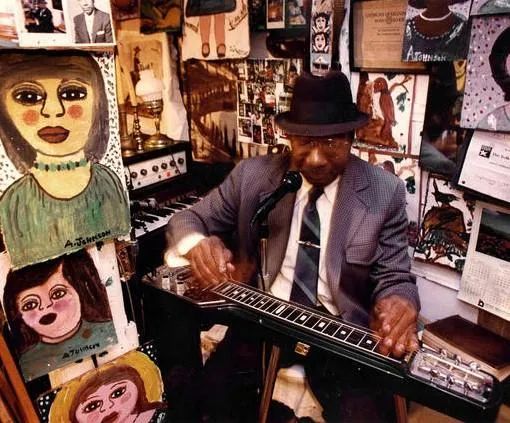Anderson Johnson
(1915 - 1998)
Elder Anderson Johnson: Sacred Steel Musician, Preacher, and Artist
Early Life and Spiritual Calling
Born on August 1, 1915, 70 miles outside of Richmond, Virginia, Elder Anderson Johnson grew up in a rural farming community as one of six children to Richard and Lucy Wilson Johnson. His passion for music emerged at six years old after witnessing his mother’s friend play the guitar, igniting a lifelong devotion to the instrument. At the age of eight, Johnson began preaching, an extraordinary calling that would shape his entire career. His religious conviction deepened after surviving a lightning strike during a thunderstorm in Lunenburg, Virginia, further fueling his commitment to ministry. By age twelve, he had already become the pastor of a church in Vineland, New Jersey, demonstrating his remarkable spiritual leadership at an early age.
Musical and Evangelical Journey
Throughout his youth, Johnson worked diligently, earning enough money at a barbershop to purchase his first guitar. He spent the next 40 years traveling across the United States, preaching and performing gospel music, spreading his faith through song and sermon. At age 19, he set out across the country in a beat-up Chevy, embracing his life as a traveling evangelist and musician. His talent caught the attention of Henry Stone in 1952, while he was performing gospel on a Miami street corner. This encounter led to a record deal, marking the beginning of his recording career. He released notable works, including "God Don’t Like It" in 1958, recording under Angel, Glory, and Deluxe labels in Miami, Florida.
Artistic and Musical Legacy
Eventually settling in Newport News, Virginia, Johnson built his own church and established himself as a respected outsider artist. His paintings, predominantly portraits of women, became a distinctive element of his creative expression. Beyond his steel guitar expertise, he was also an accomplished pianist and drummer, showcasing his versatility as a musician. Elder Anderson Johnson spent his career preaching and playing his steel guitar on the streets of America, leaving behind a lasting legacy of faith, music, and art.

FAQS
What is Sacred Steel?
Sacred Steel is an African-American gospel tradition that features the steel guitar in religious services. It originated in Pentecostal churches in the 1930s
Where did Sacred Steel originate?
It developed in the Church of the Living God, particularly in the Keith and Jewell Dominions.
How did Sacred Steel gain popularity?
Sacred Steel gained wider recognition through performances by artists like Robert Randolph, Calvin Cooke, Aubrey Ghent and the Campbell Brothers, who brought the genre to international fame.
God Bless Sacred Steel!

